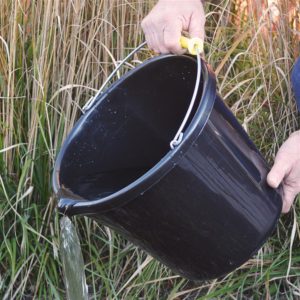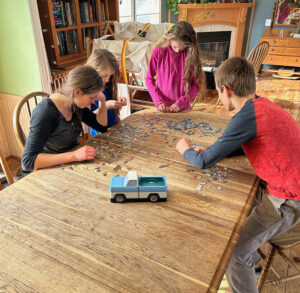Thanksgiving has come and gone, Christmas is behind us and a new year has begun. We’ve endured weeks of colder

weather and the shortest day of the year. It’s a full three months until even a hint of warm spring days. What can a person, couple or family do to avoid a bout of cabin fever?
Consider a leisurely walk with a twist. January is THE month to put on a pair of comfortable walking shoes and appropriate layers (depending on the weather) and head for the nearest field edges or woodlot to look for treasures left behind by that big deer you kept seeing all fall.
The hobby is called “hunting sheds.†Anyone who can get to an area deer frequent can do it. Finding a discarded antler can be fun. Looking for them can be an ideal escape from the mundane winter blahs. And you can take your new treasure and make rustic décor, clothing items, or even snacks for the tiny animals in your yard.
If it’s such a fun and rewarding hobby, why only hunt sheds in the dead of winter? The main reason is because they might not be around come spring. Antlers contain calcium. Many animals, both wild and domestic, require an amount of calcium in their diet. While domestic animals can get the necessary calcium through additives in store-bought food, wild animals must forage for their necessary minerals. Everything from squirrels to field mice will feed on shed antlers as a calcium source. It’s not uncommon to find a shed antler as early as late January or early February that already has gnaw marks showing. As time progresses, discarded antlers will become more bleached by the sun and elements and become

easier to spot in the woods. But by then it’s rare to find a fully intact antler. Gnawed pieces can often be found along small animal game trails.
A fact unknown to many people is that deer, elk and other antler-bearing animals shed their headgear each year. Antlers are not horns. Horns remain in place throughout an animal’s life span, and contain active flowing blood vessels and “live†marrow. They are hard on the outside, similar to a fingernail or toenail on a human. Constant wear and genetics determines the ultimate size of horns.
Antlers grow new each spring and fall off each winter. While growing, they are covered in a thin layer of fur-covered skin known as “feltâ€. By late summer the felt begins to dry up and flake away as the antler beneath it hardens and stops growing. The animal will “rub†the felt covering from the antlers by rubbing them against a small tree — often a cedar or pine, but sometimes a hardwood sapling. The damage caused to the tree is called a “rubâ€, while the process is often called “polishing.†It’s likely you may have spotted a deer in late summer with what looked like strips of skin hanging from its antlers. The buck was not done polishing its headgear yet.
Once the fall mating season, or “rutâ€, is complete, a buck will be exhausted and suffering from weight loss and general

fatigue. About that time a chemical change begins to take place in the animal. One result of that change is the loosening of the previous year’s antlers. The deer’s antlers will begin to itch as they start to release from the skull. At some point the antlers will tear loose from the small amount of skin attached at the base — the wide area of the antler known as a “rosette†or “bud.†This usually happens in late December or early January. A close look at a shed antler will reveal a rough patch on the rosette, while an antler physically removed from a dead deer following a successful hunt will have a smooth cut or saw marks visible.
Both antlers rarely tear loose at the same time, so they will likely fall at two different locations along his travel paths. He’ll even wander around for a time as a one-antlered deer.
Unless completely driven from an area, a buck will remain within a couple mile range his entire lifetime. The best places to look for shed antlers is along travel paths deer use traveling between feeding and bedding areas. If you hunt, or know someone who does, start looking where a buck was spotted in the fall. Following a game path for a short distance can turn up fresh tracks or droppings. While female deer, or “does,†generally don’t grow and shed antlers, there are occasional natural anomalies with all species of creatures. Besides, finding any deer trail is a likely sign of finding antlers since both male and female deer often use the same travel paths.

It’s not an exact science, but a healthy, growing buck will often add two new points to its antler set with each additional year until it fully matures and eventually begins waning. So a one-year-old buck will often have skin-covered nubs of antlers called “buttons.†The next year the deer might have two one-pronged antlers, called a “spike buck.†The next year the new antlers might have forks making it a “four-point rack.†The next year the new antlers might have two additional points besides the main beam, making it a “six point†buck, and so on. But then again, there are genetic oddities and other factors which can accelerate or slow antler point addition each passing year.
Every set of antlers will be different, which is part of the fun of finding one. Less healthy bucks, or those with bad genetics, can have very small racks which curve in close together and don’t grow thick. These are often called “basket†racks. Very healthy bucks, or those who benefit from conservation methods such as food plots, mineral licks and such or have exceptional genetics, can have large racks with thick tines, a wide spread and many points. Racks with unique shapes, uneven number of points from side to side, or oddities such as tines growing in unusual directions (a tine growing downward is called a “drop tineâ€), are lumped into the category of “non-typical†racks.
A shed hunting outing can be as simple as spending an hour or so walking in the woods and happening upon a dropped antler on occasion. Or it can be as involved as setting out to search a particular area for the antlers of a deer seen in the area in the weeks or months earlier. It can be a great accomplishment to find a three-point antler one year and then find a four-point antler on the same trail the following year — leaving you with the question of whether the sheds perhaps came from the same animal in subsequent years. Finding a “non-typical†or exceptionally large shed antler, or even a pair of antlers that seem to have belonged to the same animal, can be a real trophy.

Look for the antlers where deer trails — paths with hoof prints, droppings, or nearby rubs — pass either close to or through thick brush or briars. It’s here that post-rut bucks often accidentally hook their loose antlers on foliage and leave them behind.
When walking in the woods of field edges wear good footwear and consider carrying a staff for additional stability on uneven terrain.
Found antlers can be put on a shelf for decoration with other outdoor memorabilia, be made into a candle holder or paperweight as a craft project, or added to other antlers to create a lamp or chandelier. Antler portions can be made into buttons, broaches, keychain fobs, or knife or letter opener handles. To cut buttons from a main antler beam using a small coping or other fine-toothed hand saw. To drill holes in antler buttons, or to mount the tang of a knife blank or homemade blade, use a small drill bit. An electric drill will work, but a small brace and bit is easier to control to avoid damage to the project. Knife or letter opener blanks can be bought, or made from saw blades or files. We have hunting knives made from blanks with antler handles, and I own a letter opener and muzzle loader patch knife made from files and smaller antler portions.
A matching set of sheds, both the left and right, can be mounted on a display kit available from hunting, general or taxidermy stores. Another fun and inexpensive use of antlers, especially if they’ve already be chewed on by small animals or are otherwise undesirable, is to cut them into pieces two to three inches long. Now drill a small hole near one end of the segments and string them together with baling wire or other small string or wire. Hang or secure them near feeders in your backyard or from low tree branches to make “chew toys†for squirrels.

I have a friend who used the tips of antlers to make a necklace which appears at first glance to have been adorned with bear claws. The antler tips are easier to find, simpler to work with, and are “legal†to possess.
I’ve been hunting shed antlers for some two decades. Most people I know who’ve tried it once and found an antler have returned to do it again. It can become a bright spot in often long, slow winter months.
Remember that finding a shed antler means the buck that left it behind was still alive after the last rifle season. That means he’ll likely still be in the area come next winter … and may just leave behind another gift.

































